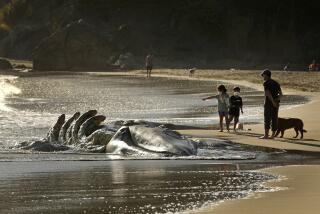Corals on Great Barrier Reef will never be the same after back-to-back heat waves, scientists say
- Share via
The Great Barrier Reef suffered a catastrophic die-off after two back-to-back marine heat waves in 2016 and 2017, a new study finds – and many of its reef communities have been fundamentally changed.
The grim discovery, described in the journal Nature, reveals just how vulnerable many coral species are to rising ocean temperatures and shows that these vital habitats will continue to be affected if global warming continues unabated.
Thanks to decades of greenhouse gases released by human activity, global warming has been heating the oceans and impacting the health of marine life around the world. Corals are particularly sensitive, because when the heat goes up, their symbiotic algae start producing toxic levels of oxygen and the corals have to expel them. After these “bleaching” events, the corals lose their color, and without their symbionts they’re vulnerable. Some of them can recover, while others ultimately die.
These losses have implications not just for the corals, but for the species that rely on them. That includes humans, particularly in coastal nations in poorer regions that rely heavily on fishing and fisheries.
Then in 2016, the hottest year in recorded history, an extreme heat wave spread through the world’s oceans, triggering bleaching events in many vulnerable reefs.
Lead author Terry Hughes, a coral reef ecologist at James Cook University in Australia, wanted to measure the extent of the damage to the Great Barrier Reef, a rich ecosystem that includes more than 3,860 individual reefs over roughly 1,500 miles. A World Heritage Area, the reef system serves as a crucial habitat for many endangered species.
He and a large team of researchers took boats, airplanes and helicopters low over the ocean to track the Great Barrier Reef’s health. They returned again about eight months later around the time of yet another marine heat wave in the region.
The scientists found that in combination, the two heat waves had killed about half of the corals on the Great Barrier Reef. The first event hit the northern third of the reef the hardest, while the second did more damage in the middle third.
While many of the most sensitive corals died immediately from heat exposure, many others died in the months that followed after they had been bleached and then been unable to recover.
“One of the concerns around the coral reef world is that the gap between pairs of bleaching events is shrinking,” Hughes said.
That’s because corals take a long time to recover after bleaching events – the fastest ones might take a decade, while the slower ones take centuries. In the 1980s and 1990s, when bleaching events happened once every 25 years on average, such communities could recover. Since 2010, Hughes said, the gap has shrunk to just six years. That kind of one-two punch — such as the back-to-back heat waves of 2016 and 2017 — can knock out even the more resilient coral species.
This means the coral communities that make up the Great Barrier Reef have already been fundamentally altered, Hughes said. There’s no going back to the way it was.
But there’s still hope, he added. After all, roughly half of the corals are still alive. If humans stick to keeping rising global temperatures within the limits set by the Paris climate accords, there’s a chance for the corals that remain.
“It will recover,” Hughes said of the reef system. “The question is, to what?”
Follow @aminawrite on Twitter for more science news and “like” Los Angeles Times Science & Health on Facebook.
MORE IN SCIENCE
One of the solar system’s early planets didn’t survive, but its diamonds are now on Earth
Organs from drug overdose victims could save the lives of patients on transplant waiting list
NASA is about to step up its planet-hunting game with the launch of TESS







